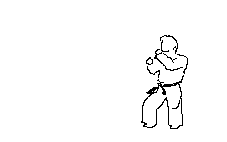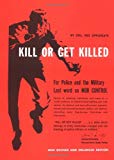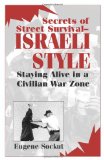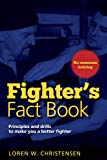Brazilian Jiu-Jitsu
 Brazilian Jiu-Jitsu is an advanced form of the Japanese martial art of the same name. It has been modified by the famous Gracie Family of Brazil to become “arguably the most effective martial art in the world.” With the arrival of Brazilian Jiu-Jitsu on the martial arts scene, it has forever changed the way fighters train. From now on, no true martial artist, regardless of style, will ever neglect to include Brazilian ground-fighting techniques in his training schedule. Without learning the proper ways to defend and execute techniques from the Brazilian Jiu-Jitsu arsenal it is difficult to survive against a good Brazilian Jiu-Jitsu Fighter.
Brazilian Jiu-Jitsu is an advanced form of the Japanese martial art of the same name. It has been modified by the famous Gracie Family of Brazil to become “arguably the most effective martial art in the world.” With the arrival of Brazilian Jiu-Jitsu on the martial arts scene, it has forever changed the way fighters train. From now on, no true martial artist, regardless of style, will ever neglect to include Brazilian ground-fighting techniques in his training schedule. Without learning the proper ways to defend and execute techniques from the Brazilian Jiu-Jitsu arsenal it is difficult to survive against a good Brazilian Jiu-Jitsu Fighter.
The Gracie family has proven the merit of this art by entering numerous “no-holds-barred” fights and remaining undefeated for over 70 years. Brazilian Jiu-Jitsu is predominantly a ground-fighting art. The Gracie fighter’s objective is to avoid punches and kicks while attempting to clinch his opponent. Once in the clinch, the opponent’s strikes are rendered ineffective. The Brazilian Jiu-Jitsu fighter will then proceed to take the fight to the ground where his opponent’s strikes will not have any power behind them. Taken out of his game, the striker is helpless, without the ability to use his stand-up skills. With the fact that 95% of all fights go to the ground, an experienced and well trained Brazilian Jiu-Jitsu Fighter will eventually take any type of fighter to the ground. Bruce Lee once said that in a fight between a boxer and a wrestler, the wrestler will always win.
Brazilian Jiu-Jitsu is the most advanced form of wrestling in the world, and the most efficient way of beating a good Brazilian Jiu-Jitsu stylist is by being a better Brazilian Jiu-Jitsu stylist. The world famous Gracie family stands as a shining example of the proven methods they teach, reigning undefeated in the arena of “no-holds-barred” combat. The form of Jiu-Jitsu they created is a Martial Art that is designed to adapt to any type of Fighting Style or Martial Art, making it reality based. This is a tested and proven style, art, and science.It is important to note that not 1 form of fighting style or martial art can defeat every other style completely every time. This is because it can depend on many factors such as: strength, size, skill or technique level, the use of weapons, multiple fighters, sport rules, fighting objectives (to control, tap out, hurt badly, or kill an opponent) etc. On a 1 on 1 open handed (no weapons) fight, it has tamed styles such as Kung Fu, Karate, Judo, Boxing, Kickboxing, Shootfighting, Wrestling, Sambo, Vale Tudo, Pancrase, Luta Livre, Pitfighting, Jeet Kune Do, Taekwondo, some forms of Ninjutsu, and even it’s parent style of Japanese Jiu-Jitsu. It has last notably been proven by Royce Gracie’s undefeated record in the “Ultimate Fighting Championship”, (a popular sport of no holds bar competition between any fighting style, as seen on the live Pay Per View event).
The defense techniques are all based on leverage, making it possible for the fighter to beat stronger and heavier opponents, bringing a sense that no one can beat you. Jiu-Jitsu is not based on strength; it uses the opponents strength and force against themselves. The key is balance (known as “base”) and leverage. Typical positions include the “guard”, the “mount”, and the “side-mount”, from which a host of attacks can be made, such as chokes, arm-bars, and joint-locks. 95% of all fights end up grappling on the ground.
There is really no underlying principle of Gracie Jiu-Jitsu other than to use what is most effective in any given situation. There is a strong emphasis on ground grappling but this is strictly reality based. Gracie Jiu-Jitsu is a complete martial art, with strikes, turns, throws, joint locks, twists and limb breaking holds. They emphasize for each student what they simply refer to as the “self defense program”,which consists of simple and effective escapes and counters from grabs, bear hugs and so on, progressing into defenses against weapons, knife and gun disarms etc. After this the student learns the unique and deadly chokes and locks of the system, which can render an attacker powerless in seconds. However, it is the undeniably devastating ground grappling which makes Gracie Jiu-Jitsu one of the most feared and respected martial arts known to man.
“It’s not like wrestling,” according to Rorion Gracie. “In wrestling, the whole object is to pin the attackers back to the ground. For a Gracie Jiu-Jitsu fighter, it doesn’t matter if you wind up with your back on the ground. The fight still goes on. As a matter of fact, there’s alot you can do with your back on the ground.”When a Gracie fighter applies there moves, it is almost like a chess game in motion. Every move or strike is instantly countered: each lock or hold can flow into another with astonishing sophistication. Gracie Jiu-Jitsu is also uniquely characterized by “flying locks”,where the entry into the hold is instantaneous. For example, an attacker may lead with a punch, only to find his arm and neck clamped into an unbreakable lock. He is then taken to the ground where the Gracie fighter may force a submission, or continue to administer punishment. Simply, purity.
As far as is known, only one other Brazilian learned Jiu-Jitsu from Maeda, and went on to teach. So, for the most part, the Gracies were the only source of Jiu-Jitsu in Brazil. Students of Gracie Jiu-Jitsu began teaching themselves, severing ties with the Gracies. Thus, Brazilian Jiu-jitsu was born. Some say Gracie Jiu-Jitsu, being the original Brazilian art, is in some ways more effective than Brazilian Jiu-Jitsu. They say, “The water is much more pure if you draw it from the source.” Yet others state that, “Gracie Jiu-Jitsu is old, the new style is Brazilian Jiu-Jitsu which is a more refined style because it is constantly evolving, developing, experimenting, and testing the art, science and style”. The main difference between the Gracie style and the Brazilian style is that: The Gracie style leans more towards self defense in a real street fight, no holds barred, and no rules fight. The Brazilian style is a more technical form leading towards the sport of it.
The latest evolution of the art is a form of Brazilian Jiu-Jitsu which makes reality a sport, combining both disciplines and incorporates cross training martial arts. A knowledge of ground-fighting is therefore essential, not just for a complete martial arts background but also for self-defense. Carlson Gracie affirms that no other martial art addresses ground fighting as effectively as Gracie Jiu-Jitsu. This art is different from most other martial arts in that it is very realistic in its training. Here are some of the main reasons why it’s different and why this art is so effective.
- We train with the assumption that our opponent will most likely be larger, stronger, and know how to fight. This is opposed to many martial arts which assume the attacker will not be skilled at fighting.
- We fight exactly the way we train. We practice our techniques exactly the way we do them in a fight. This is opposed to many martial arts styles which spend hours and hours practicing forms which scarcely resemble what the person’s body will be doing in an actual fight.
- We test everything we do by spending a great deal of time sparring under varying conditions against people with different types of training and different body styles. We spar realistically in our club (full contact) and have rarely had a serious injury. We also test our abilities in competitions (both tournament Jiu Jitsu and no rules). This is opposed to martial artists who say that it is too dangerous to spar or spar realistically. So they don’t.
In the late 1800’s a style of fighting was taught and practiced in Japan called Jiu-Jitsu. In 1914, Japanese Jiu-Jitsu Champions Esai Maeda and Inomata arrived in Brazil to help establish a Japanese immigration colony in that developing country. He was aided by Gastao Gracie, a Brazilian Scholar, a successful business man with strong political influence, and of Scottish decent. Having little money and being the representative of the colony, he wanted to give something in return. To show his gratitude, the oriental master taught the basic secrets of that ancient fighting style to Gastao’s son, Carlos Gracie. Carlos became obsessed with the traditional Japanese methods and studied for four years.
At the age of 18, he moved south to Rio de Janeiro and began teaching and in 1925 he opened the first jiu-jitsu Academy in Botafogo, a district of Rio de Janeiro, Brazil. Eventually, his brothers Osvaldo, Gastao Jr., and Jorge learned the art and trained with Carlos. Helio, being very weak because of cronic sickness, was forbidden to train by doctors, so he watched. One day when Carlos was late for class, Helio worked with the student because he knew the student’s level. As they trained, Helio began to adapt the techniques to be based on leverage instead of strength. This began the transformation of traditional Jiu-jitsu into Gracie Jiu-Jitsu. Carlos, who was interested in street-fighting and was also a boxer, modified the classical techniques learned from Count Koma to meet the demands of a real, “no rules” fighting situation. Carlos then tested and refined his system through constant matches, open to all challengers. Advertisements were placed in newspapers and on street corners, challenging anyone and everyone, regardless of size, weight, or fighting style. Carlos was never defeated, and became a legend in Brazil. Helio became the most adept fighter in the family, and the mastermind in developing new techniques. Helio began teaching the classes himself, and Carlos was impressed. Knowing he had an able successor, Carlos retired from teaching and began studying nutrition.
Over time, they developed their system into a very comprehensive fighting art, very seldom losing challenge matches. Helio then entered the professional fighting world, challenging Japanese Judo and Jiu-jitsu fighters, professional boxers, and professional brawlers. Two of his most famous bouts were the only two he lost in his life. Masahiko Kimura, 7th Dan, considered the greatest Judoka to ever live, was to be the first man to defeat Helio Gracie. Kimura boldly stated that if Helio lasted more than 3 minutes, he should consider himself the winner. Helio fought Kimura for 15 minutes before being caught in an arm lock. Fearful of having his brother’s arm shattered, Carlos threw in the towel. Tremendously impressed with the little Brazilian, the Japanese masters invited Helio to come to Japan and teach, an almost unheard of request. Respectfully, Helio declined.
Waldemar Santana was a student of Helio’s, and a powerfully built stone cutter. Much younger than Helio, it is said that Santana purposefully waited until Helio was sick with the flu to challenge him. Against Carlos’ wishes to postpone, Helio accepted, and lost after 3 hrs. 45 min. Helio quickly became the family’s best fighter, and taught many champions. When Helio lost to Santana, Carlos, who managed his brothers’ fighting careers, decided to let another family member step into the limelight. Carlson Gracie Sr. was chosen to retrieve the family’s honor by fighting Santana. Santana accepted the challenge, and lost badly to Carlson. While Carlson quickly earned the respect of the fighting world, Helio dedicated his time to teaching. Carlson became the best active fighter in the family, fourth best in Gracie history and went on to produce an almost unbelievable record of over 600 undefeated fights. Now retired from the ring, Carlson’s mission in life is to make champions. His “champion factory” in Brazil has produced some of the best black belts, and he hopes to produce the same level of champion at his Los Angeles Academy as well.
Helio and his brothers taught many, and are still teaching, turning out the best Brazilian Fighters. They went on to further refine the art via constant no-rules competition, developing what is now known as Gracie Jiu-Jitsu. Rickson Gracie is widely accepted as the greatest Brazilian Jiu-Jitsu technician and the best fighter in the world, with a career record of over 400 victories and no losses.




